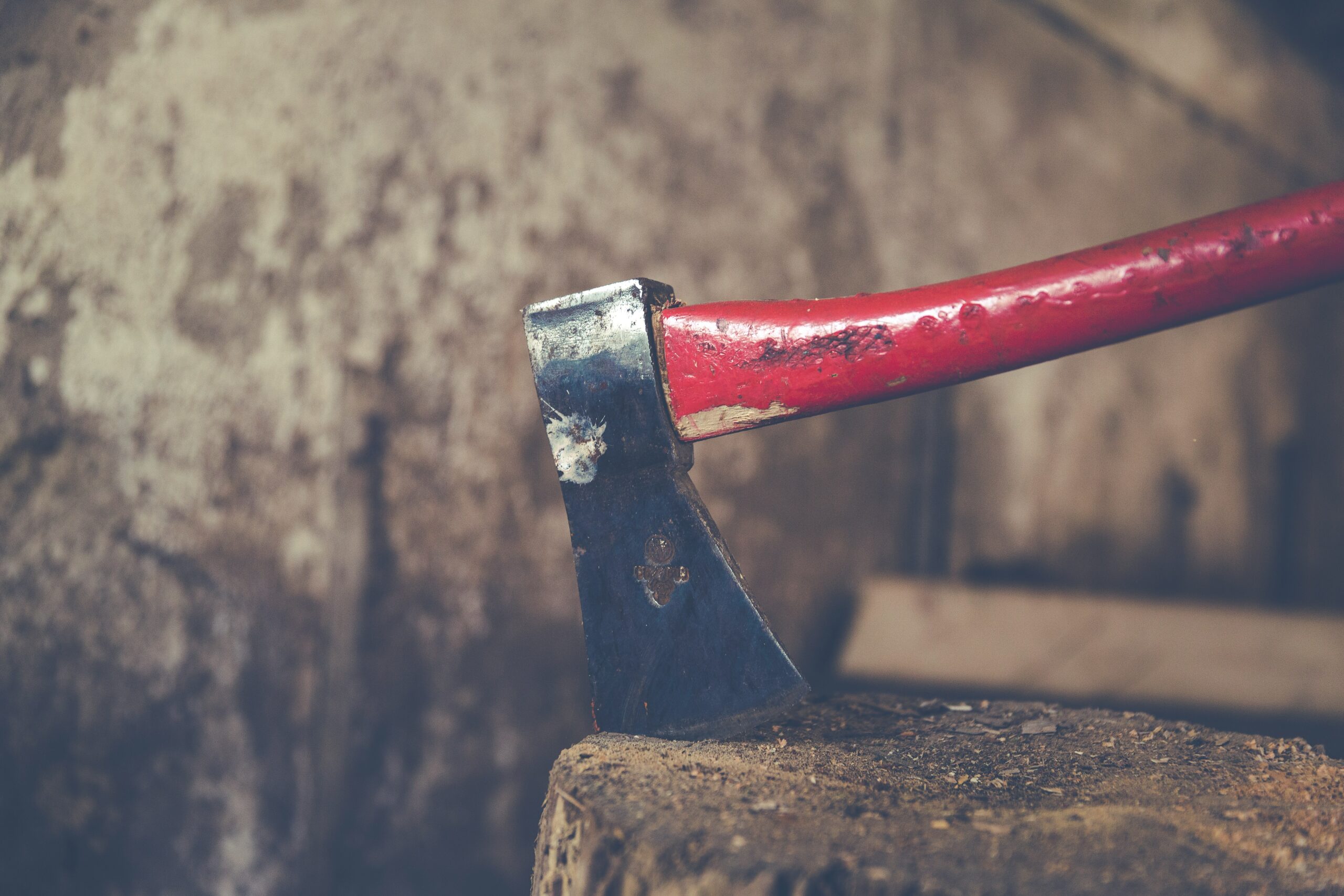Axe throwing is thrilling, but safety must come first. This guide covers essential axe throwing safety measures, focusing on proper gear selection, safe throwing techniques, and creating a secure environment.
You’ll learn how to protect yourself and others while enjoying this exciting sport. Whether you’re planning a birthday event or just starting out, these tips will help you throw axes safely and confidently. Remember, the right safety approach is your best insurance against accidents in the throwing space.
Key Takeaways
- Proper safety protocols and equipment are crucial for a secure axe-throwing experience
- Mastering safe throwing techniques, including grip and stance, is essential for preventing injuries
- Venues must establish clear safety zones, barriers, and guidelines for both indoor and outdoor settings
- Ongoing safety training and participant responsibility contribute to a culture of safety in axe-throwing
- Collaboration with safety organizations and staying informed about regulations enhance overall safety practices
The Importance of Axe Throwing Safety Measures
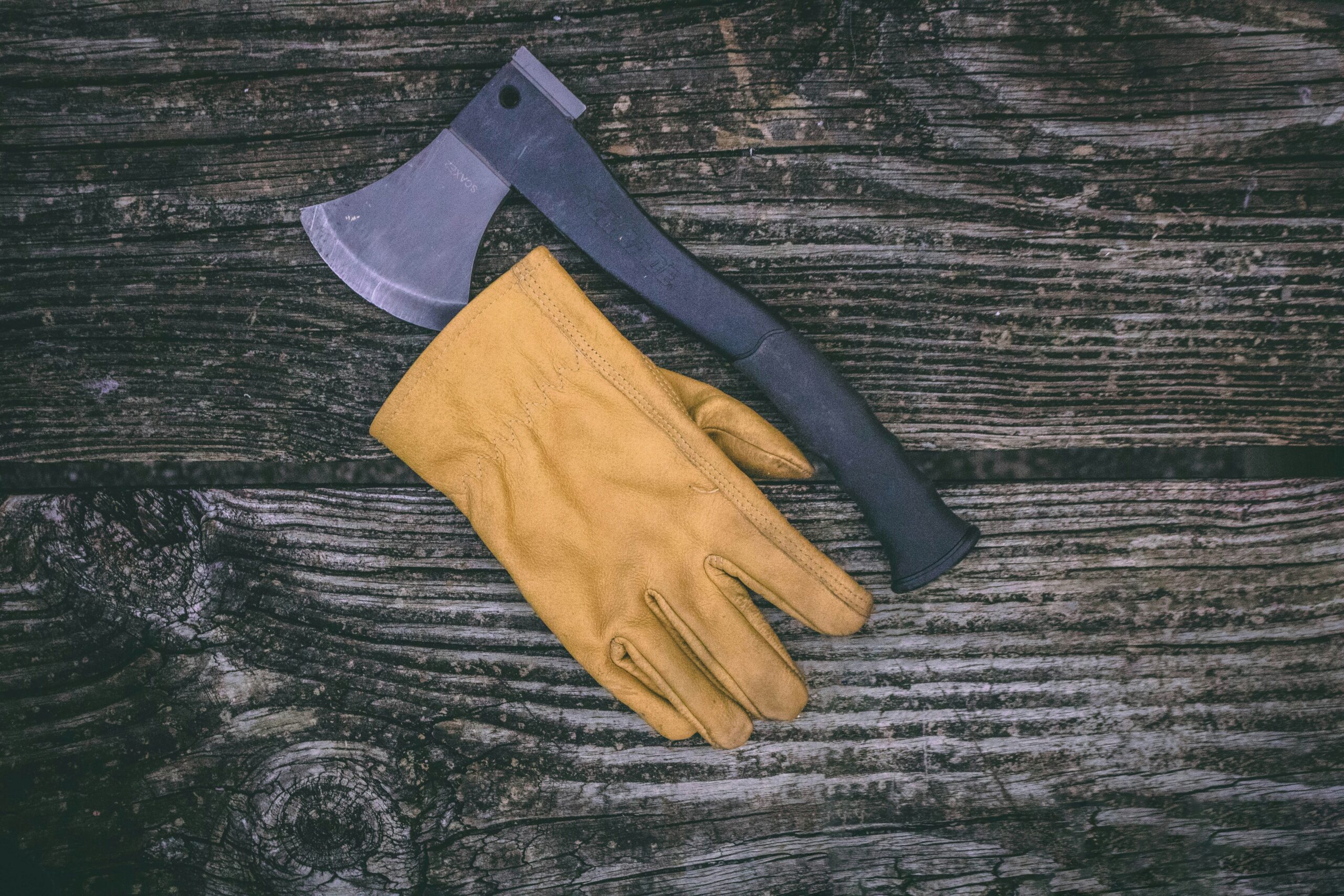
Axe throwing safety measures are crucial for a secure and enjoyable experience. Understanding the risks associated with this sport helps participants avoid accidents and injuries. Implementing proper safety protocols, including correct throwing techniques and equipment use, ensures a safe environment for all. These measures apply to both casual throwers and competitive participants, where safety remains a top priority.
Understanding the Risks Associated With Axe Throwing
Axe throwing, while an exciting form of entertainment, comes with inherent risks that participants must understand. The World Axe Throwing League emphasizes safety protocols to prevent accidents caused by improper behavior or equipment use.
Throwers should be aware of potential hazards, such as ricochets from plywood targets or injuries from mishandled axes. It’s crucial to maintain a clear head and avoid drinking alcohol before or during throwing sessions to ensure safe participation in this thrilling sport.
Benefits of Implementing Proper Safety Protocols
Implementing proper safety protocols in axe throwing provides numerous benefits for participants and venues alike. These measures protect throwers from potential injuries caused by mishandled axes or ricocheting wood, ensuring a secure environment for this exciting sport.
Proper protocols also encourage responsible behavior, discouraging alcohol consumption during sessions and highlighting the importance of eye protection. By prioritizing safety, axe-throwing venues create a positive experience that allows participants to fully enjoy the thrill of this unique activity.
Selecting the Right Safety Equipment for Axe Throwing
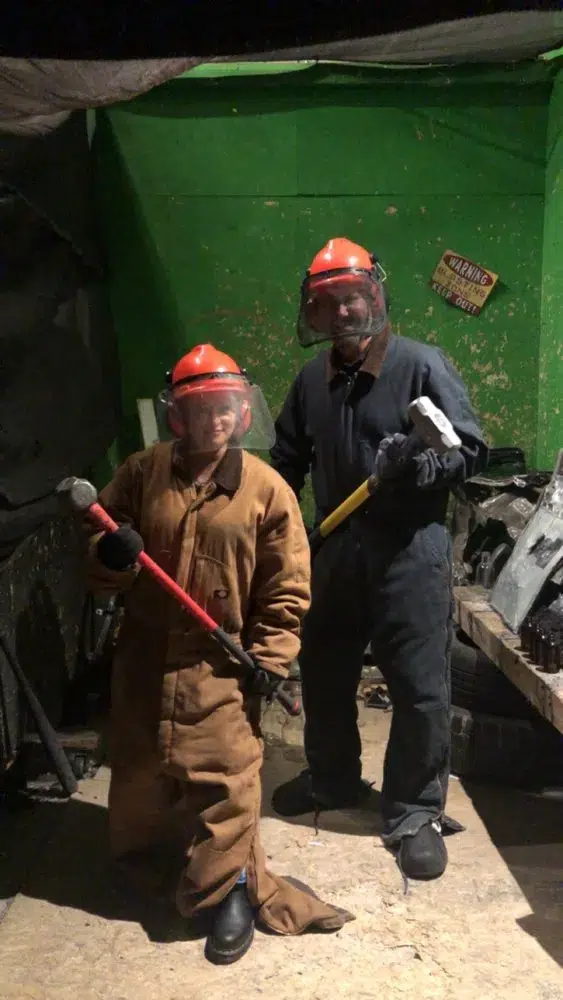
Selecting the right safety equipment is crucial for axe throwing. This section covers choosing safe axes, essential protective gear, and equipment inspection. Proper clothing, waivers, and understanding of axe rotation are key. From hatchets to full-size axes, each piece of equipment plays a role in ensuring a safe and enjoyable experience for all participants.
Choosing Axes Designed for Safe Throwing
Selecting the right axe is crucial for safe throwing. Axes designed for throwing typically have a shorter handle, making them easier to control and reducing the risk of injury. These specialized axes come in various sizes and are suitable for different skill levels and party settings, from casual gatherings to bachelorette parties.
When choosing an axe, consider factors like weight distribution and head design to ensure proper rotation during throws. Many axe-throwing venues offer gift cards, allowing participants to experience the thrill of throwing with professionally selected, safe equipment.
Essential Protective Gear for Participants
Protective gear is essential for safe axe throwing, with participants requiring proper equipment to prevent injuries. Closed-toe shoes protect feet from falling axes, while safety glasses shield eyes from potential wood splinters. The throwing area should have a sturdy fence to contain axes and maintain a safe distance between throwers and spectators.
Participants must understand proper throwing techniques, including grip and momentum control, to achieve a bullseye while minimizing risks. Axe length and weight also play crucial roles in safety, with shorter handles providing better control for beginners.
Inspecting Equipment Before Each Use
Regular equipment inspection is crucial for axe-throwing safety. Before each session, throwers should check their axes for loose heads, cracked handles, or other damage that could compromise safety.
Targets and backstops also require an inspection to ensure they’re secure and free from excessive wear. This proactive approach helps prevent accidents and ensures a safe, enjoyable experience for all participants.
Mastering Safe Axe Throwing Techniques
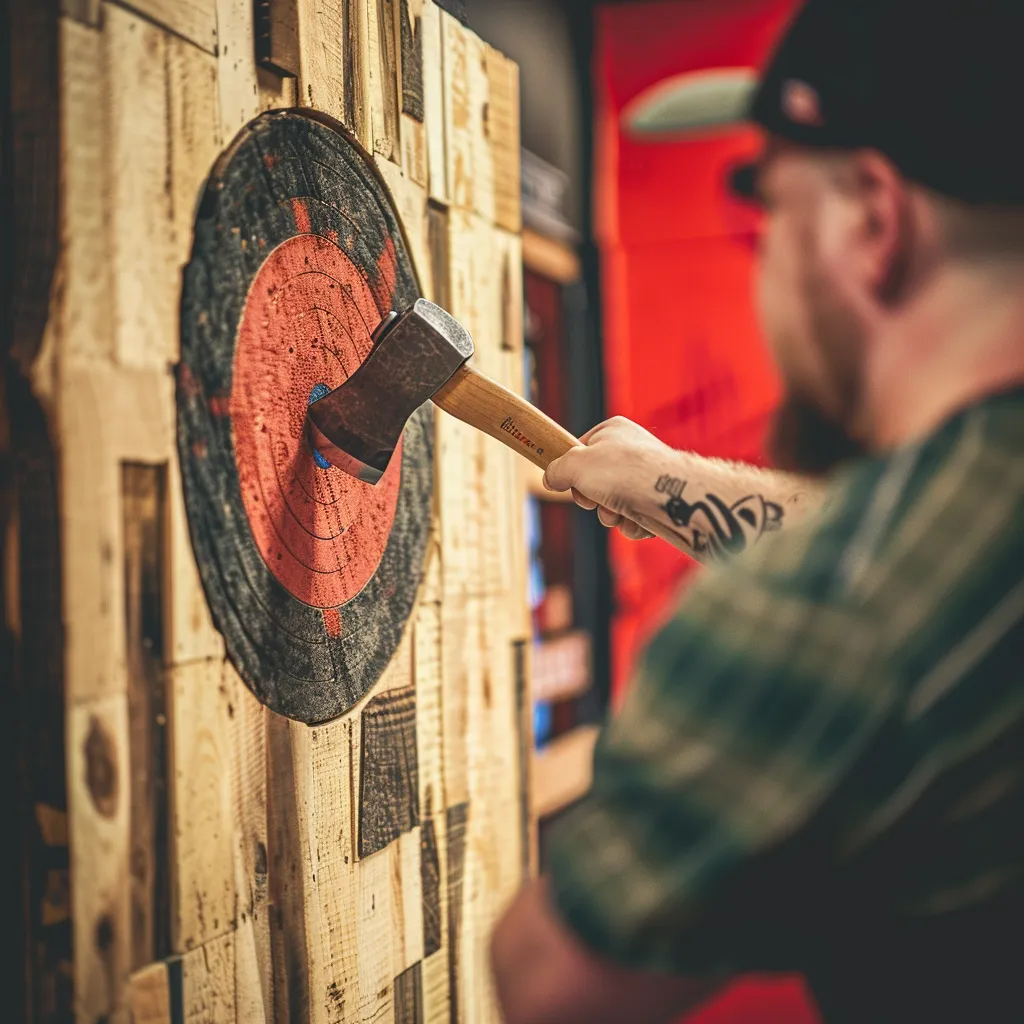
Mastering safe axe-throwing techniques is crucial for an enjoyable and secure experience. This section covers proper grip and stance, a step-by-step guide to safe throws, practicing controlled and consistent throws, and avoiding common mistakes that lead to injuries. By following these guidelines, throwers can improve their skills while prioritizing safety.
Learning Proper Grip and Stance
A proper grip and stance form the foundation of a safe axe-throwing technique. Throwers should hold the axe at the bottom of the handle with their dominant hand, keeping a firm but relaxed grip. The stance involves standing with feet shoulder-width apart and the body facing sideways to the target.
This positioning allows for a smooth, controlled throw while maintaining balance. Key elements of a safe grip and stance include:
- Placing the dominant hand at the base of the axe handle
- Keeping a relaxed yet secure grip
- Standing sideways to the target
- Maintaining shoulder-width foot placement
- Aligning body for a smooth throwing motion
Step-by-Step Guide to a Safe Throw
A safe axe throw involves a smooth, controlled motion. The thrower starts with the axe at shoulder height, steps forward with the opposite foot, and brings the axe down and forward in a fluid arc. As the axe approaches the release point, the thrower extends its arm and lets go, allowing it to rotate once before striking the target. Proper timing and release are crucial for accuracy and safety, ensuring the axe hits the target blade first without bouncing back or falling short.
Practicing Controlled and Consistent Throws
Practicing controlled and consistent throws is essential for safe axe throwing. Throwers should focus on maintaining a steady rhythm and repeating the same motion with each throw. This consistency helps develop muscle memory, leading to more accurate and safer throws over time. Regular practice sessions, starting with shorter distances and gradually increasing, allow throwers to refine their technique while prioritizing safety.
Avoiding Common Mistakes That Lead to Injuries
Avoiding common mistakes is crucial for preventing injuries in axe throwing. Throwers should refrain from overexerting themselves or using excessive force, which can lead to loss of control. Maintaining proper form throughout the throw and avoiding twisting motions or releasing the axe too early or late is important.
Participants must also respect safety zones and never attempt to catch a falling axe. By being aware of these potential pitfalls and focusing on proper technique, throwers can significantly reduce the risk of accidents and enjoy a safer axe-throwing experience.
Establishing a Safe Axe-Throwing Environment
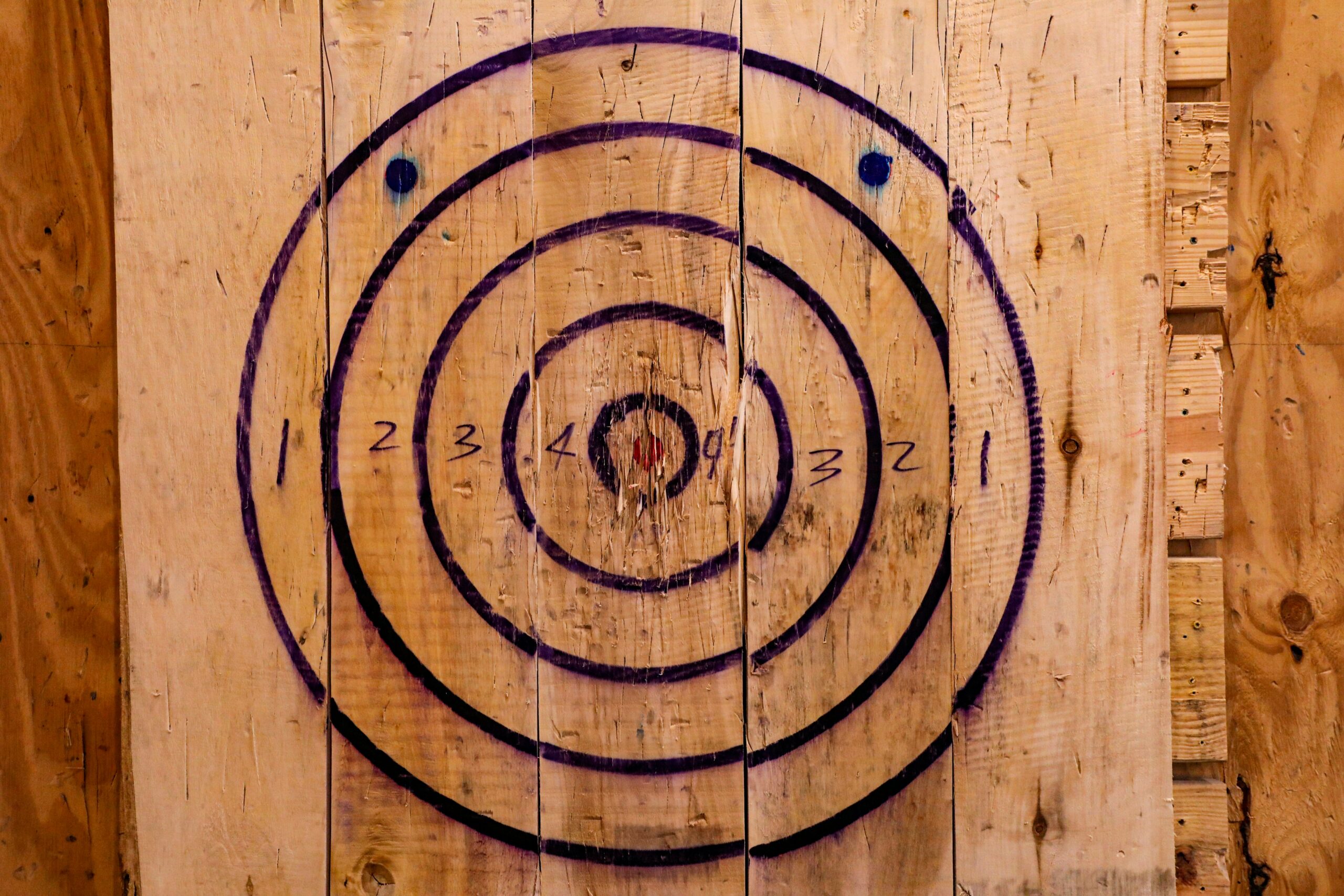
Establishing a safe, axe-throwing environment is crucial for participant and bystander safety. This section covers setting up secure throwing ranges, implementing safety zones and barriers, guidelines for indoor and outdoor venues, and ensuring bystander safety. By following these measures, axe-throwing venues can create a safe and enjoyable experience for all.
Setting Up a Secure Throwing Range
Setting up a secure throwing range is essential for axe-throwing safety. The range should have sturdy targets made of softwood, typically pine or poplar, mounted on a solid backboard. Lanes must be clearly marked and separated by fencing or netting to prevent axes from crossing into adjacent areas.
Proper lighting is crucial for visibility, and non-slip flooring helps throwers maintain their footing. The throwing line should be clearly marked and set at the appropriate distance from the target, usually around 12 to 15 feet for standard axes.
Implementing Safety Zones and Barriers
Implementing safety zones and barriers is crucial for axe-throwing venues. Designated throwing areas should be clearly marked and separated from spectator zones by physical barriers such as fences or netting.
These barriers prevent stray axes from entering non-throwing areas and protect bystanders. Safety zones should extend beyond the immediate throwing area to account for potential ricochets or bounces. Proper signage and floor markings help guide participants and spectators, ensuring everyone understands and respects the safety boundaries.
Guidelines for Indoor and Outdoor Venues
Indoor and outdoor axe-throwing venues require specific safety guidelines. To prevent accidents, indoor facilities must have proper ventilation, adequate lighting, and non-slip flooring. Outdoor venues need weather-resistant targets, clear boundary markers, and protection from environmental hazards. Both types of venues should follow these essential safety measures:
- Clearly marked throwing lines and safety zones
- Secure target backboards and fencing
- First aid kits and trained staff on-site
- Regular equipment inspections and maintenance
- Proper signage explaining safety rules and procedures
Ensuring Bystander Safety at All Times
Ensuring bystander safety is paramount in axe-throwing environments. Venues must establish clear spectator areas separated from throwing zones by physical barriers. Staff should monitor these areas, enforcing rules that prevent unauthorized entry into throwing lanes.
Proper signage and announcements help educate spectators about safety protocols, ensuring they remain vigilant and aware of their surroundings at all times.
Conclusion
Axe-throwing safety measures are crucial for creating a secure and enjoyable environment for all participants. Implementing proper techniques, using appropriate equipment, and maintaining a well-designed throwing range significantly reduce the risk of accidents and injuries.
Ongoing education, clear communication of safety protocols, and fostering a culture of responsibility among throwers and staff are essential for long-term safety in axe throwing. By prioritizing safety through collaboration, adherence to regulations, and continuous improvement, axe-throwing venues can ensure this thrilling sport remains both exciting and secure for years to come.

